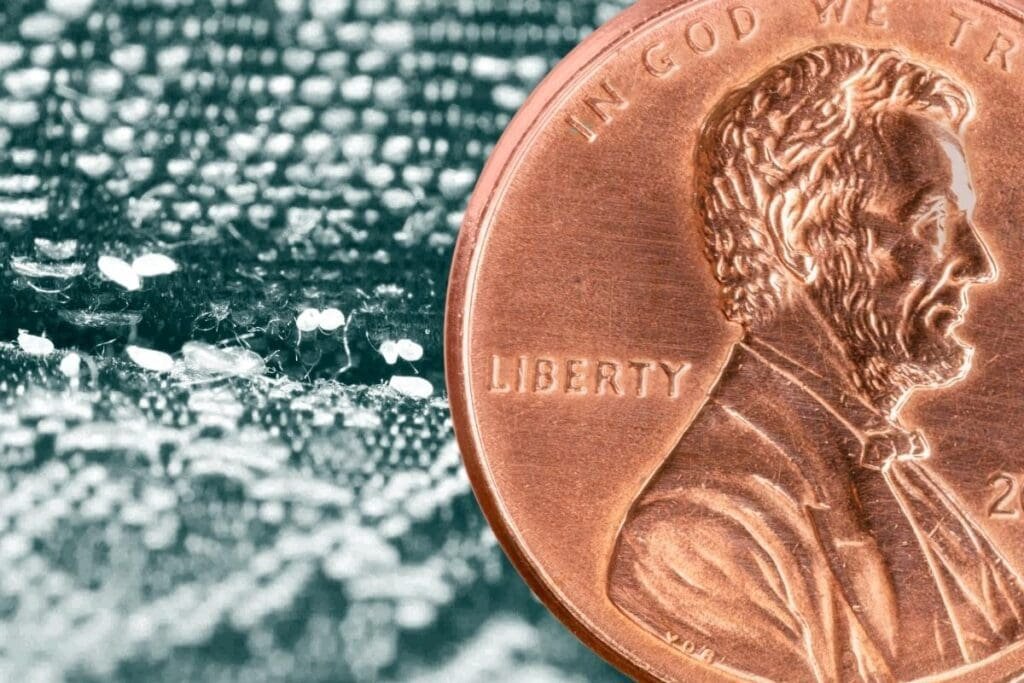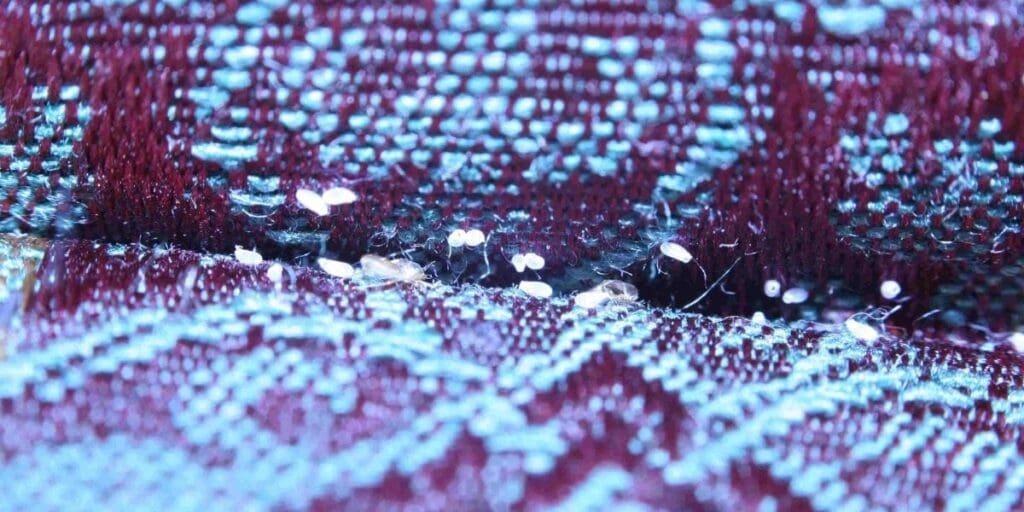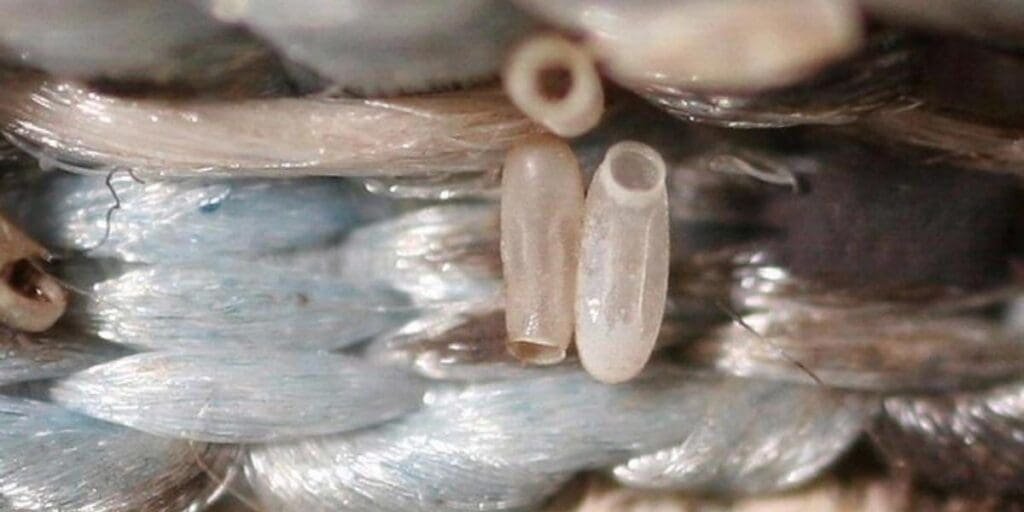
Wondering what bed bug eggs look like? Although they’re considered an early sign of a bed bug infestation, most people find bed bug eggs difficult to recognize and identify with certainty.
If you discover tiny, white particles on your mattress or in your furniture, how do you know if they’re bed bug eggs, food crumbs, plastic debris, or something else?
In this article, we’ll explain what bed bug eggs look like and how to tell if you have them in your home. (Jump to pictures of bed bug eggs.)
What Do Bed Bug Eggs Look Like?
Bed bug eggs are long and oval-shaped, resembling tiny grains of rice.
The front end of the egg has a hinged cap from which the baby bed bug emerges. If the egg has already hatched, you might see an opening at one end, sometimes with the cap still attached like an opened door.
If the egg is more than 5 days old, a tiny reddish-brown dot called an eye spot becomes visible near the cap or opening. However, it’s very hard to see without a microscope.
How Big Are Bed Bug Eggs?
Bed bug eggs are around 1 millimeter long—approximately the thickness of a credit card or the size of a pinhead.
Although they’re very small, you can see bed bug eggs with just your naked eye. It might be difficult to make out any of the distinguishing features we mentioned above, but you should be able to determine their general size and shape.
Here’s a graphical size comparison of bed bug eggs next to a penny. The length of an egg is slightly longer than the letter “L” in “Liberty”.

What Color Are Bed Bug Eggs?
The color of bed bug eggs ranges from pearly white to pale yellow. Unhatched eggs are somewhat translucent, while hatched eggs are hollow and almost entirely transparent.
Freshly laid bed bug eggs sometimes have a shiny appearance, due to the sticky, glue-like liquid that female bed bugs use to cover their eggs. This sticky substance keeps keep the eggs securely in place on the surfaces that they’re laid on, which sometimes includes vertical walls or the undersides of furniture.
As the glue hardens, the surface of the eggs will take on a duller white or pale yellow color.
Are Bed Bug Eggs Hard or Soft?
Bed bug eggs are soft to the touch and smooth on the surface. They can be easily squashed or smeared.
Unhatched eggs are filled with fluid and will pop under a small amount of pressure. If you hold one in tissue paper and pinch it, you can burst the egg and crush the developing bed bug nymph inside.
Squashing a bed bug egg isn’t exactly a pleasant experience for most people, but it’s one way to check if what you’ve found is really a bed bug egg. If it’s dry and crumbles, then it’s most likely some other sort of debris.
On the other hand, bed bug eggs that have already hatched are empty inside and may feel dry or wrinkled.
Due to the glue-like coating, bed bug eggs are usually found stuck to surfaces. Unlike dirt or debris, eggs are hard to pick up by hand and may need to be scraped off of the surfaces you find them on.
Pictures of Bed Bug Eggs









Frequently Asked Questions: Bed Bug Eggs
Where Do Bed Bugs Lay Eggs?
Bed bug eggs are most often found near harborage areas where bed bugs congregate. The most common places to find bed bug eggs include:
- Mattresses and mattress seams
- Box springs
- Bed frames
- Pillows and pillowcases
- Nightstands and dressers
- Couches
- Bookshelves
- Other furniture
- Cracks in walls and baseboards
- Rugs and carpets
- Home appliances
- Light switches and electrical outlets
How Do You Kill Bed Bug Eggs?
The easiest way to kill any bed bug eggs that you find is to crush them. Use a tissue or paper towel to dislodge them from whatever surface you found them on and then apply a bit of pressure to squash them.
If you don’t want to get your hands dirty, you can use a thin card to scrape them off and then vacuum them up. However, bed bug eggs can sometimes survive a trip through the vacuum hose, so it’s important to empty your vacuum into a sealed bag for disposal afterwards.
If you’ve discovered bed bug eggs clinging to bedsheets or clothing, washing and drying them at temperatures of at least 120 °F is enough to kill them.
For upholstered furniture, a steamer can be a good option. Steam forms from water at 212 °F, which is hot enough to instantly kill any bed bugs and their eggs.
Does Alcohol Kill Bed Bug Eggs?
Yes, isopropyl alcohol (rubbing alcohol) can be lethal to bed bug eggs. However, we do NOT recommend it.
In high enough concentrations and quantities, alcohol dissolves and desiccates the eggs to prevent them from hatching. But in real life scenarios, alcohol alone is usually insufficient.
In one study from Ohio State University, researchers found that even a heavy application of 100% rubbing alcohol killed less than 40% of bed bug eggs it was sprayed on.
Part of the reason why alcohol isn’t recommended as a solution for bed bug eggs is because it requires direct contact. In a bed bug infestation, eggs are often hidden in clusters in hard-to-reach spaces. Alcohol also evaporates quickly, sometimes disappearing before the egg is destroyed.
Lastly, it’s important to note that rubbing alcohol is flammable. There have been cases where people have accidentally started fires when trying to use alcohol to kill bed bugs and their eggs.
Can Bleach Kill Bed Bug Eggs?
Yes, bleach can kill bed bug eggs but it’s NOT recommended.
Bleach is a harsh chemical cleaning solution that contains sodium hypochlorite. This reacts with water to produce hypochlorous acid, which breaks down and kills bed bugs and their eggs.
However, bleach must come into direct contact with bed bugs and their eggs in order to be effective. Bed bug eggs are often hidden in places that are hard to reach with a bleach solution.
The risks of using bleach to kill bed bug eggs often outweigh the benefits. Bleach is toxic and can cause serious health problems if mishandled. It can also damage or discolor the surfaces that the bed bug eggs are on.
How Many Eggs Do Bed Bugs Lay?
On average, a single female bed bug lays 200 to 250 eggs in its lifetime, according to the University of Minnesota. In a single day, it can lay between 4 to 7 eggs.
How Many Bed Bugs Are in One Egg?
Bed bugs are monoembryonic. One bed bug egg normally contains a single bed bug nymph.
How Long Do Bed Bug Eggs Take to Hatch?
Bed bug eggs typically require about 1–2 weeks to hatch, but this varies depending on the temperature. At temperatures above 70 °F, bed bug eggs can hatch as quickly as in 6–10 days. At lower temperatures, they may take as long as 28 days to hatch.
What Temperature Kills Bed Bugs and Their Eggs?
Adult bed bugs and their eggs will die within minutes if temperatures reach 122 °F (50 °C).
Slightly lower temperatures can also be used, but more time is required. According to entomologist Dini M. Miller, Ph.D., bed bugs exposed to temperatures of 118 °F need 20 minutes to reach 100% mortality.
Bed bug eggs are slightly more resilient to heat than adult bed bugs. At 118 °F, eggs require 90 minutes of heat exposure to be killed.
At MMPC, we provide professional bed bug heat treatments using ambient heat at high temperatures to efficiently and reliably exterminate bed bugs and bed bug eggs.
